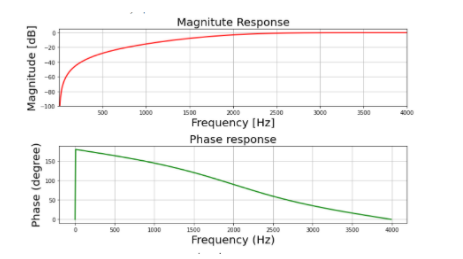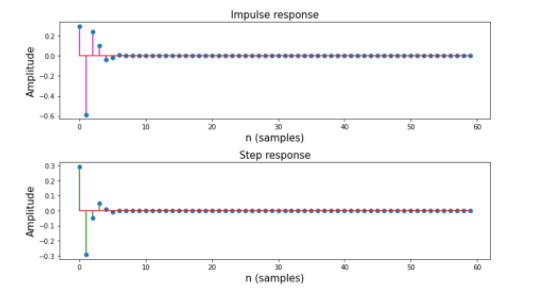Разработайте БИХ-фильтр верхних частот Баттерворта с использованием метода билинейного преобразования в Scipy - Python
IIR расшифровывается как Infinite Impulse Response, это одна из ярких особенностей многих систем, инвариантных по линейному времени, которые отличаются наличием импульсной характеристики h (t) / h (n), которая не становится нулевой после некоторой точки, а вместо этого продолжается бесконечно. .
Что такое IIR Highpass Butterworth?
По сути, он ведет себя так же, как обычный цифровой высокочастотный фильтр Баттерворта с бесконечной импульсной характеристикой.
Технические характеристики следующие:
- Частота полосы пропускания: 2-4 кГц
- Частота стоп-полосы: 0-500 Гц
- Пульсация полосы пропускания: 3 дБ
- Затухание в полосе задерживания: 20 дБ
- Частота дискретизации: 8 кГц
- Мы построим график амплитуды, фазы, импульса, переходной характеристики фильтра.
Пошаговый подход:
Шаг 1: Импорт всех необходимых библиотек.
Python3
# import required libraryimport numpy as npimport scipy.signal as signalimport matplotlib.pyplot as plt |
Шаг 2: Определение пользовательских функций mfreqz () и impz () . mfreqz - это функция для амплитуды и фазового графика, а impz - это функция для импульсной и ступенчатой характеристики.
Python3
def mfreqz(b, a, Fs): # Compute frequency response of the filter # using signal.freqz function wz, hz = signal.freqz(b, a) # Calculate Magnitude from hz in dB Mag = 20 * np.log10( abs (hz)) # Calculate phase angle in degree from hz Phase = np.unwrap(np.arctan2(np.imag(hz), np.real(hz))) * ( 180 / np.pi) # Calculate frequency in Hz from wz Freq = wz * Fs / ( 2 * np.pi) # START CODE HERE ### (≈ 1 line of code) # Plot filter magnitude and phase responses using subplot. fig = plt.figure(figsize = ( 10 , 6 )) # Plot Magnitude response sub1 = plt.subplot( 2 , 1 , 1 ) sub1.plot(Freq, Mag, 'r' , linewidth = 2 ) sub1.axis([ 1 , Fs / 2 , - 100 , 5 ]) sub1.set_title( 'Magnitute Response' , fontsize = 20 ) sub1.set_xlabel( 'Frequency [Hz]' , fontsize = 20 ) sub1.set_ylabel( 'Magnitude [dB]' , fontsize = 20 ) sub1.grid() # Plot phase angle sub2 = plt.subplot( 2 , 1 , 2 ) sub2.plot(Freq, Phase, 'g' , linewidth = 2 ) sub2.set_ylabel( 'Phase (degree)' , fontsize = 20 ) sub2.set_xlabel(r 'Frequency (Hz)' , fontsize = 20 ) sub2.set_title(r 'Phase response' , fontsize = 20 ) sub2.grid() plt.subplots_adjust(hspace = 0.5 ) fig.tight_layout() plt.show() # Define impz(b,a) to calculate impulse response# and step response of a system input: b= an array# containing numerator coefficients,a= an array containing#denominator coefficientsdef impz(b, a): # Define the impulse sequence of length 60 impulse = np.repeat( 0. , 60 ) impulse[ 0 ] = 1. x = np.arange( 0 , 60 ) # Compute the impulse response response = signal.lfilter(b, a, impulse) # Plot filter impulse and step response: fig = plt.figure(figsize = ( 10 , 6 )) plt.subplot( 211 ) plt.stem(x, response, 'm' , use_line_collection = True ) plt.ylabel( 'Amplitude' , fontsize = 15 ) plt.xlabel(r 'n (samples)' , fontsize = 15 ) plt.title(r 'Impulse response' , fontsize = 15 ) plt.subplot( 212 ) step = np.cumsum(response) # Compute step response of the system plt.stem(x, step, 'g' , use_line_collection = True ) plt.ylabel( 'Amplitude' , fontsize = 15 ) plt.xlabel(r 'n (samples)' , fontsize = 15 ) plt.title(r 'Step response' , fontsize = 15 ) plt.subplots_adjust(hspace = 0.5 ) fig.tight_layout() plt.show() |
Шаг 3: Определите переменные с заданными характеристиками фильтра.
Python3
# Given specificationFs = 8000 # Sampling frequency in Hzfp = 2000 # Pass band frequency in Hzfs = 500 # Stop Band frequency in HzAp = 3 # Pass band ripple in dBAs = 20 # Stop band attenuation in dB # Compute Sampling parameterTd = 1 / Fs |
Шаг 4: Расчет частоты среза
Python3
# Compute cut-off frequency in radian/secwp = 2 * np.pi * fp # pass band frequency in radian/secws = 2 * np.pi * fs # stop band frequency in radian/sec |
Шаг 5: предварительная установка частоты среза
Python3
# Prewarp the analog frequencyOmega_p = (2/Td)*np.tan(wp*Td/2) # Prewarped analog passband frequencyOmega_s = (2/Td)*np.tan(ws*Td/2) # Prewarped analog stopband frequency |
Шаг 6: вычисление фильтра Баттерворта
Python3
# Compute Butterworth filter order and cutoff frequencyN, wc = signal.buttord(Omega_p, Omega_s, Ap, As, analog = True ) # Print the values of order and cut-off frequencyprint ( 'Order of the filter=' , N)print ( 'Cut-off frequency=' , wc) |
Выход:

Шаг 7. Разработайте аналоговый фильтр Баттерворта, используя N и wc с помощью функции signal.butter ( ).
Python3
# Design analog Butterworth filter using N and# wc by signal.butter functionb, a = signal.butter(N, wc, 'high' , analog = True ) # Perform bilinear Transformationz, p = signal.bilinear(b, a, fs = Fs) # Print numerator and denomerator coefficients# of the filterprint ( 'Numerator Coefficients:' , z)print ( 'Denominator Coefficients:' , p) |
Выход:

Шаг 8: Построение графика амплитуды и фазовой характеристики
Python3
# Call mfreqz function to plot the# magnitude and phase responsemfreqz(z, p, Fs) |
Выход:

Шаг 9: Построение импульсной и ступенчатой характеристики
Python3
# Call impz function to plot impulse and# step response of the filterimpz(z, p) |
Выход:

Ниже представлена реализация:
Python3
# import required libraryimport numpy as npimport scipy.signal as signalimport matplotlib.pyplot as plt # User defined functions mfreqz for# Magnitude & Phase Responsedef mfreqz(b, a, Fs): # Compute frequency response of the filter # using signal.freqz function wz, hz = signal.freqz(b, a) # Calculate Magnitude from hz in dB Mag = 20 * np.log10( abs (hz)) # Calculate phase angle in degree from hz Phase = np.unwrap(np.arctan2(np.imag(hz), np.real(hz))) * ( 180 / np.pi) # Calculate frequency in Hz from wz Freq = wz * Fs / ( 2 * np.pi) # START CODE HERE ### (≈ 1 line of code) # Plot filter magnitude and phase responses using subplot. fig = plt.figure(figsize = ( 10 , 6 )) # Plot Magnitude response sub1 = plt.subplot( 2 , 1 , 1 ) sub1.plot(Freq, Mag, 'r' , linewidth = 2 ) sub1.axis([ 1 , Fs / 2 , - 100 , 5 ]) sub1.set_title( 'Magnitute Response' , fontsize = 20 ) sub1.set_xlabel( 'Frequency [Hz]' , fontsize = 20 ) sub1.set_ylabel( 'Magnitude [dB]' , fontsize = 20 ) sub1.grid() # Plot phase angle sub2 = plt.subplot( 2 , 1 , 2 ) sub2.plot(Freq, Phase, 'g' , linewidth = 2 ) sub2.set_ylabel( 'Phase (degree)' , fontsize = 20 ) sub2.set_xlabel(r 'Frequency (Hz)' , fontsize = 20 ) sub2.set_title(r 'Phase response' , fontsize = 20 ) sub2.grid() plt.subplots_adjust(hspace = 0.5 ) fig.tight_layout() plt.show() # Define impz(b,a) to calculate impulse# response and step response of a system# input: b= an array containing numerator# coefficients,a= an array containing#denominator coefficientsdef impz(b, a): # Define the impulse sequence of length 60 impulse = np.repeat( 0. , 60 ) impulse[ 0 ] = 1. x = np.arange( 0 , 60 ) # Compute the impulse response response = signal.lfilter(b, a, impulse) # Plot filter impulse and step response: fig = plt.figure(figsize = ( 10 , 6 )) plt.subplot( 211 ) plt.stem(x, response, 'm' , use_line_collection = True ) plt.ylabel( 'Amplitude' , fontsize = 15 ) plt.xlabel(r 'n (samples)' , fontsize = 15 ) plt.title(r 'Impulse response' , fontsize = 15 ) plt.subplot( 212 ) step = np.cumsum(response) # Compute step response of the system plt.stem(x, step, 'g' , use_line_collection = True ) plt.ylabel( 'Amplitude' , fontsize = 15 ) plt.xlabel(r 'n (samples)' , fontsize = 15 ) plt.title(r 'Step response' , fontsize = 15 ) plt.subplots_adjust(hspace = 0.5 ) fig.tight_layout() plt.show() # Given specificationFs = 8000 # Sampling frequency in Hzfp = 2000 # Pass band frequency in Hzfs = 500 # Stop Band frequency in HzAp = 3 # Pass band ripple in dBAs = 20 # Stop band attenuation in dB # Compute Sampling parameterTd = 1 / Fs # Compute cut-off frequency in radian/secwp = 2 * np.pi * fp # pass band frequency in radian/secws = 2 * np.pi * fs # stop band frequency in radian/sec # Prewarp the analog frequencyOmega_p = ( 2 / Td) * np.tan(wp * Td / 2 ) # Prewarped analog passband frequencyOmega_s = ( 2 / Td) * np.tan(ws * Td / 2 ) # Prewarped analog stopband frequency # Compute Butterworth filter order and cutoff frequencyN, wc = signal.buttord(Omega_p, Omega_s, Ap, As, analog = True ) # Print the values of order and cut-off frequencyprint ( 'Order of the filter=' , N)print ( 'Cut-off frequency=' , wc) # Design analog Butterworth filter using N and# wc by signal.butter functionb, a = signal.butter(N, wc, 'high' , analog = True ) # Perform bilinear Transformationz, p = signal.bilinear(b, a, fs = Fs) # Print numerator and denomerator coefficients of the filterprint ( 'Numerator Coefficients:' , z)print ( 'Denominator Coefficients:' , p) # Call mfreqz function to plot the magnitude# and phase responsemfreqz(z, p, Fs) # Call impz function to plot impulse and step# response of the filterimpz(z, p) |
Выход:




Внимание компьютерщик! Укрепите свои основы с помощью базового курса программирования Python и изучите основы.
Для начала подготовьтесь к собеседованию. Расширьте свои концепции структур данных с помощью курса Python DS. А чтобы начать свое путешествие по машинному обучению, присоединяйтесь к курсу Машинное обучение - базовый уровень.